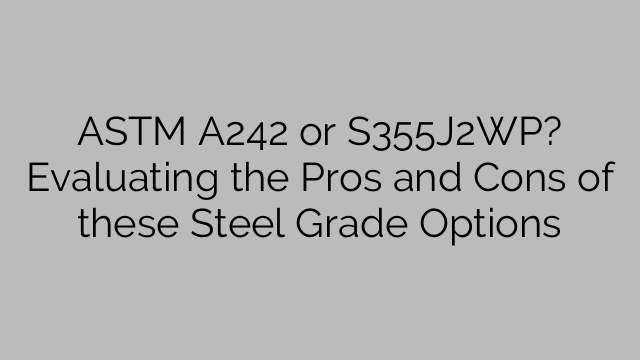ASTM A242 or S355J2WP? Evaluating the Pros and Cons of these Steel Grade Options
When it comes to selecting the right steel grade for a particular application, one must consider various factors such as durability, strength, resistance to corrosion, and cost-effectiveness. Two common options that are often compared are ASTM A242 and S355J2WP. Both these grades are weathering steel specifications that offer unique advantages and disadvantages. In this article, we will evaluate the pros and cons of these steel grade options to help you make an informed decision.
ASTM A242 is a high-strength low-alloy structural steel that is known for its corrosion resistance. It offers excellent atmospheric corrosion resistance due to the formation of a protective oxide layer on the steel’s surface when exposed to the elements. This property eliminates the need for painting or other protective coatings, making it a cost-effective solution for outdoor structures. Additionally, ASTM A242 has good weldability, machinability, and formability, allowing for versatile application possibilities.
One major advantage of ASTM A242 is its high yield strength, which provides exceptional structural stability. It is well-suited for applications where weight reduction, strength, and long-term durability are essential. Such applications may include bridges, buildings, marine structures, and architectural projects. Moreover, its improved corrosion resistance compared to regular carbon steel extends the lifespan of structures, reducing maintenance and replacement costs.
However, there are certain drawbacks to consider when choosing ASTM A242. The primary drawback is its limited availability, especially in certain shapes and sizes. This can lead to longer lead times and potentially higher material costs. Additionally, ASTM A242 may not be suitable for environments with high chloride concentrations, such as coastal areas, as it may be susceptible to localized corrosion in such conditions. Proper evaluation of the specific project conditions is crucial before selecting this steel grade.
On the other hand, S355J2WP is a European standard weathering steel grade that offers similar benefits to ASTM A242. It provides excellent atmospheric corrosion resistance and has a higher phosphorus content than other weathering steel grades, enhancing its atmospheric corrosion resistance further. S355J2WP is commonly used in construction industries, such as bridges, railway vehicles, and shipping containers, where durability and aesthetic appeal are paramount.
The advantage of S355J2WP lies in its improved mechanical properties, including higher tensile strength and yield strength compared to ASTM A242. This makes it suitable for applications requiring higher load-bearing capacities. Additionally, its availability in various shapes and sizes allows for flexibility in design and construction projects.
Like ASTM A242, S355J2WP also has certain limitations. Its primary drawback is its higher cost compared to conventional carbon steel. Furthermore, while it exhibits excellent weather resistance, it may not be as corrosion-resistant as stainless steel. Therefore, proper maintenance and periodic inspections are necessary to ensure its long-term performance.
In conclusion, both ASTM A242 and S355J2WP offer unique advantages depending on the specific application. ASTM A242 provides excellent atmospheric corrosion resistance, high yield strength, and cost-effectiveness, while S355J2WP boasts improved mechanical properties and versatile availability. However, each steel grade has its limitations, necessitating careful consideration of the project requirements and environmental conditions. Consulting with industry professionals and conducting thorough research will help make an informed decision and ensure the selection of a steel grade that best suits the intended purpose.

